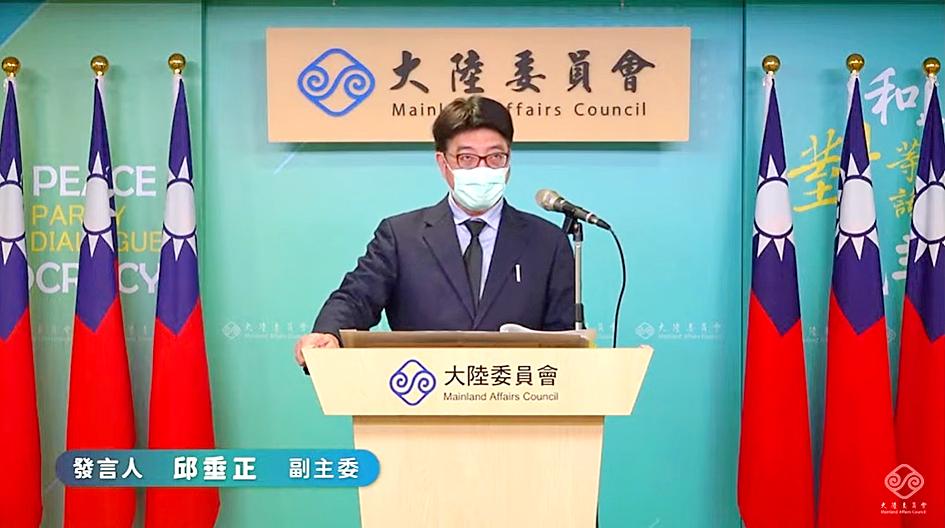A pro-unification pop song aired on Chinese television earlier this month would only further sour Taiwanese sentiment toward China, the Mainland Affairs Council (MAC) said on Wednesday.
The music video for We Sing the Same Song (我們同唱一首歌), which aired on China Central Television, features Chinese artists performing alongside Taiwanese singers Jam Hsiao (蕭敬騰), Ouyang Nana (歐陽娜娜) and Chen Li-nong (陳立農).
The lyrics were reportedly written by Taiwanese lyricist Vincent Fang (方文山), known for his collaborations with Jay Chou (周杰倫), to music composed by a Chinese musician.

Photo: Screen shot from the MAC’s online broadcast
Sung in Chinese and Hoklo (commonly known as Taiwanese), the song is about three Taiwanese siblings who go to China after their grandfather’s death to reunite with their family in China’s Fujian Province.
The sentimental music video features images of the singers intercut with a family sharing a meal, and an interlude showing Matsu (媽祖) statues on China’s Meizhou Island (湄洲島) and Yunlin County’s Beigang (北港) “gazing at each other across the Strait.”
China’s Taiwan Affairs Office said that the song was a coproduction between Cross-Strait Radio and the Taiwan Strait Watch media platform, both of which are part of the state broadcasting conglomerate China Media Group.
Artists on both sides of the Taiwan Strait “put their heart and soul” into creating this “Lunar New Year gift,” office spokeswoman Zhu Fenglian (朱鳳蓮) said on Wednesday.
The song fully demonstrates the homesickness felt by “Taiwanese compatriots,” she said, adding that the two sides “have always been one family.”
Responding to immense backlash to the song in Taiwan, Zhu said that “any lies, malicious incitement or provocations pale in comparison to feelings of affection and unity across the Strait.”
In Taipei, the MAC reiterated that the Republic of China is a sovereign nation that has never been part of the People’s Republic of China.
The Chinese Communist Party has long used shared history and culture to impose its idea of “one China,” turning purely artistic endeavors into propaganda tools, it said.
Pro-unification songs such as this would not only fail to win the approval of Taiwanese, but would actually increase antipathy toward China, it added.
Saying that Taiwanese society respects and upholds artistic freedom, the council urged Taiwanese to cherish their hard-won democracy and reject Chinese propaganda.
MAC spokesman Chiu Chui-cheng (邱垂正) yesterday called on Chinese propagandists to reconsider their strategy.
Rather than telling artists to produce “politically correct” propaganda, it should stop clamping down on artistic thought, respect freedom of expression and allow people to realize their creative potential, Chiu said.
Cross-strait exchanges should be approached rationally and pragmatically to reflect people’s voices and encourage positive development, he added.
Asked whether it was appropriate for Taiwanese artists to participate in the production, Chiu said that he “trusts that Taiwanese society has made its own evaluation.”
He added that there are regulations that must be followed when collaborating across the Strait, and those living or doing business in China must still abide by Taiwanese law.

Taiwan is to commence mass production of the Tien Kung (天弓, “Sky Bow”) III, IV and V missiles by the second quarter of this year if the legislature approves the government’s NT$1.25 trillion (US$39.78 billion) special defense budget, an official said yesterday. Commenting on condition of anonymity, a defense official with knowledge of the matter said that the advanced systems are expected to provide crucial capabilities against ballistic and cruise missiles for the proposed “T-Dome,” an advanced, multi-layered air defense network. The Tien Kung III is an air defense missile with a maximum interception altitude of 35km. The Tien Kung IV and V

The disruption of 941 flights in and out of Taiwan due to China’s large-scale military exercises was no accident, but rather the result of a “quasi-blockade” used to simulate creating the air and sea routes needed for an amphibious landing, a military expert said. The disruptions occurred on Tuesday and lasted about 10 hours as China conducted live-fire drills in the Taiwan Strait. The Civil Aviation Administration (CAA) said the exercises affected 857 international flights and 84 domestic flights, affecting more than 100,000 travelers. Su Tzu-yun (蘇紫雲), a research fellow at the government-sponsored Institute for National Defense and Security Research, said the air

Taiwan lacks effective and cost-efficient armaments to intercept rockets, making the planned “T-Dome” interception system necessary, two experts said on Tuesday. The concerns were raised after China’s military fired two waves of rockets during live-fire drills around Taiwan on Tuesday, part of two-day exercises code-named “Justice Mission 2025.” The first wave involved 17 rockets launched at 9am from Pingtan in China’s Fujian Province, according to Lieutenant General Hsieh Jih-sheng (謝日升) of the Office of the Deputy Chief of the General Staff for Intelligence at the Ministry of National Defense. Those rockets landed 70 nautical miles (129.6km) northeast of Keelung without flying over Taiwan,

A strong continental cold air mass is to bring pollutants to Taiwan from tomorrow, the Ministry of Environment said today, as it issued an “orange” air quality alert for most of the country. All of Taiwan except for Hualien and Taitung counties is to be under an “orange” air quality alert tomorrow, indicating air quality that is unhealthy for sensitive groups. In China, areas from Shandong to Shanghai have been enveloped in haze since Saturday, the ministry said in a news release. Yesterday, hourly concentrations of PM2.5 in these areas ranged from 65 to 160 micrograms per cubic meter (mg/m³), and pollutants were